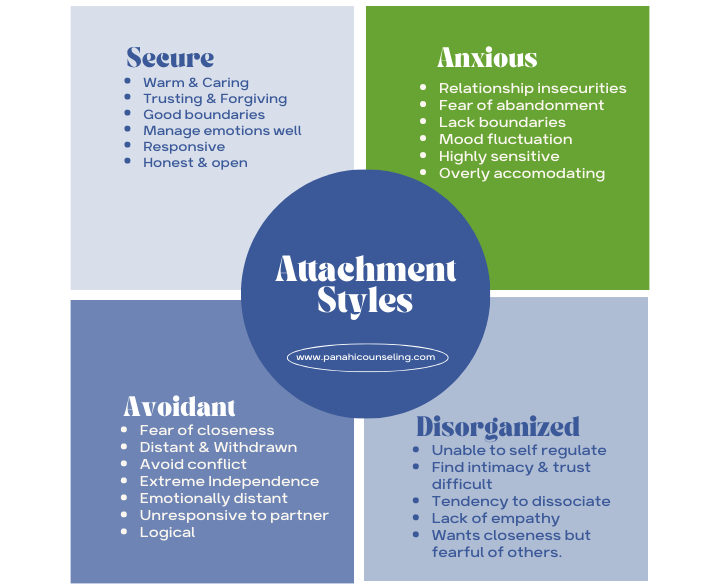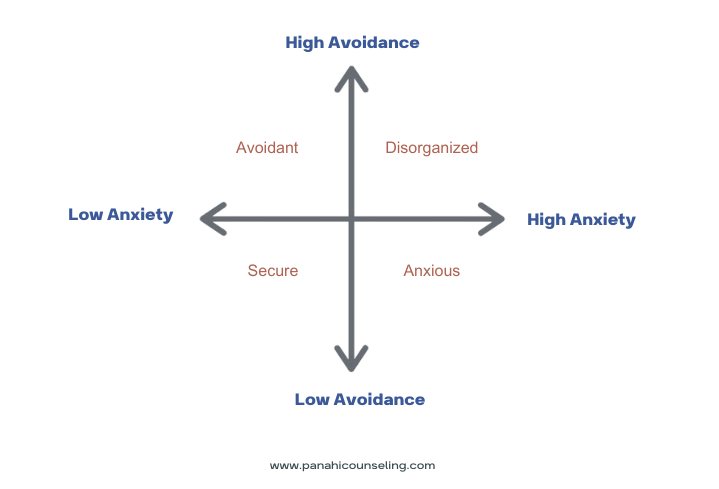attachment theory and our early development.
Attachment theory is a psychological theory that attempts to explain how people form and maintain relationships, particularly those between a child and their caregiver. Developed by John Bowlby in the mid-20th century (a), the theory posits that the quality of a child’s early relationships, specifically with their caregiver, shapes their emotional development and their ability to form healthy relationships later in life.
According to attachment theory, children develop internal working models of attachment based on the quality of their early relationships with caregivers. These internal working models guide their later relationships with others, shaping how they approach intimacy, trust, and emotional regulation. The quality of the attachment relationship is determined by the extent to which the caregiver is responsive and sensitive to the child’s needs, providing a secure base from which the child can explore the world (b).

4 Types of Attachment Styles.
There are four main types of attachment according to attachment theory: secure attachment, avoidant attachment, anxious attachment, and disorganized attachment (c).
Secure Attachment Style
Secure attachment is the most optimal type of attachment and is characterized by a child who feels comfortable exploring their environment knowing that their caregiver is available and responsive when they need them. The caregiver is consistent, responsive, and supportive, allowing the child to develop a sense of security and trust. As a result, children with secure attachment tend to be more resilient and adaptable to change, have higher self-esteem, and form healthier relationships later in life.
Common Signs of Secure Attachment in Adulthood:
- You feel at ease relying on others for support.
- You have confidence that others will offer their assistance when you need it.
- You rarely fret about the possibility of abandonment.
- Establishing close connections with others comes naturally to you.
- You don’t frequently concern yourself with the idea of someone becoming emotionally close to you.
- You are at ease with the idea of others relying on you for support.
In short, secure attachment in relationships is marked by trust, effective communication, emotional support, flexibility, and healthy boundaries, fostering a sense of safety and resilience in partnerships.
To read more on secure attachment, check out the secure attachment article.

Anxious Attachment Style
Anxious attachment is marked by a child who is clingy and anxious, constantly seeking reassurance from their caregiver but not feeling secure even when their needs are met. The caregiver may be inconsistently available, leading to a child who is never sure if they can rely on their caregiver. As a result, children with ambivalent attachment tend to be more anxious and insecure, with lower self-esteem and a greater tendency to develop psychological disorders later in life.
Common Signs of Anxious Attachment in Adulthood:
- You often experience worry or anxiety about your relationships.
- You desire closeness and intimacy with your partner but also have a fear of rejection or abandonment.
- You tend to become clingy or needy when your partner is unavailable or unresponsive.
- You frequently seek reassurance from your partner and may become jealous when they interact with others.
- You face challenges ineffectively expressing your needs and emotions within your relationships.
- You find yourself frequently questioning your partner’s genuine love for you.
- Experience intense emotions such as anxiety, toxic shame, sadness, or anger are common in your relationships.
In summary, an anxious attachment style is marked by a strong desire for closeness and reassurance in relationships, often accompanied by fears of rejection or abandonment. This can lead to clingy behavior and challenges in communication, as well as self-esteem issues and heightened emotional reactions in romantic contexts.
To read more on attachment style, check out the article on anxious attachment style.

Avoidant Attachment Style
Avoidant attachment is marked by a child who learns to avoid seeking comfort from their caregiver because their needs were consistently ignored or dismissed in the past. These children develop a coping mechanism that involves suppressing their emotional needs and minimizing their distress, leading to a tendency to withdraw from intimacy and emotional expression later in life.
Common Signs of Avoidant Attachment in Adulthood:
- You find it difficult to allow yourself to depend on others.
- It feels like people are often not there when you need them.
- You find it challenging to trust others completely.
- You may feel somewhat uncomfortable being close to others.
- You tend to get nervous when anyone gets too close.
- In romantic relationships, your partner often wants you to be more intimate than you feel comfortable being.
Avoidant attachment style is marked by a preference for independence and self-reliance in relationships, with a tendency to feel uncomfortable with emotional closeness and intimacy. Trusting others and expressing emotions can be challenging, often leading to hesitancy in forming deep connections, especially in romantic relationships.
To read more about avoidant attachment styles, check out the article on avoidant attachment styles.
Disorganized Attachment Style
Disorganized attachment is a less common type of attachment and is characterized by a caregiver who is frightening or abusive. Children with disorganized attachment may exhibit contradictory behaviors, such as approaching their caregiver for comfort but then avoiding them when they try to provide it. This is thought to result from the child’s internal conflict between their desire for comfort and their fear of the caregiver. Children with disorganized attachment are at higher risk of developing mental health problems, such as dissociative disorders, personality disorders, and post-traumatic stress disorder (PTSD).
Common Signs of Disorganized Attachment in Adulthood:
- You find it difficult to allow yourself to depend on others.
- You often feel that people aren’t there when you need them.
- Trusting others is something you struggle with.
- Being close to others can make you somewhat uncomfortable.
- You tend to get nervous when anyone gets too emotionally close.
- In romantic relationships, your partners often want you to be more intimate than you feel comfortable being.
- You experience extreme mood swings for no reason.
Disorganized attachment styles involve unpredictable and contradictory behaviors in relationships due to inconsistent caregiving or trauma. This leads to difficulties in forming secure attachments, erratic patterns of seeking and avoiding intimacy, and challenges in emotional regulation.
To read more on disorganized attachment styles, check out the article on disorganized attachment styles.
Experiencing Emotions Across The Attachment Styles
From an attachment standpoint, emotions can vary significantly depending on our attachment style. Take a look at the diagram below, which illustrates different attachment types and their associated range of feelings we might be experiencing in relationships (!).

interpretation
Low Anxiety & Low Avoidance: Individuals categorized as secure attachment tend to experience low anxiety and low avoidance. They have a positive self-image and outlook towards others stemming from consistent attentive care received. When encountering an issue with others, they find it easier to address and resolve their misunderstandings.
High anxiety & low avoidance: Those with an anxious attachment tend to experience high anxiety and low avoidance. They often hold a negative self-perception but a favorable view of others. Their behavior is marked by emotional reliance on others, pessimism, hyper-vigilance toward potential threats, and diminished self-worth.
Low anxiety & high avoidance: A person with avoidant attachment tends to have low anxiety but high avoidance tendencies. They maintain a positive self-image, seeing themselves as resilient and self-sufficient while holding a negative opinion of others due to earlier relationships being unreliable. Despite discomfort with closeness, they exhibit self-assurance. This approach involves suppressing attachment needs, shunning intimacy and dependence, and favoring self-reliance and autonomy in relationships.
High anxiety & high avoidance: Dismissive attachment individuals experience high anxiety and high avoidance tendencies. They exhibit a pessimistic view of both self and others. Like anxiously attached types, they crave social interaction but are restrained by fear of rejection. Consequently, they display a pattern of approaching and avoiding interpersonal engagements in adulthood. Like preoccupied individuals, they grapple with heightened negative emotions and low self-esteem.
Understanding the various attachment styles—secure, anxious, avoidant, and dismissive—gives us a deeper insight into the complexities of human relationships and our emotional well-being. By recognizing and understanding our attachment style and the styles of those around us, we can build stronger, more empathetic connections with others, paving the way for healthier and happier relationships.
How is attachment explored in Psychotherapy?

Attachment theory has had a significant impact on psychotherapy, with many clinicians incorporating it into their practice. Psychotherapy can be used to explore attachment styles and the impact that early relationships have had on a person’s emotional development. Here are some of the ways in which attachment is explored in psychotherapy:
- Assessment of attachment style: The first step in exploring attachment in psychotherapy is to assess a client’s attachment style. This can be done using various measures, such as self-report questionnaires or interviews. The assessment will help the therapist understand the client’s attachment history, their current attachment style, and the impact that attachment has had on their life.
- Building a secure therapeutic relationship: One of the most important aspects of psychotherapy is the therapeutic relationship between the client and therapist. Therapists who use attachment theory in their practice focus on building a secure relationship with their clients. This involves being emotionally attuned to the client’s needs, responding sensitively to their emotions, and providing a safe and supportive environment for exploration and growth.
- Identifying patterns in relationships: Attachment theory suggests that people develop patterns in their relationships based on their early attachment experiences. Psychotherapy can be used to help clients identify these patterns and explore how they impact their current relationships. For example, a client with an avoidant attachment style may have difficulty forming close relationships because they learned to suppress their emotions as a child. By identifying this pattern, the therapist can help the client learn to express their emotions and form healthier relationships.
- Processing early attachment experiences: Psychotherapy can also be used to process early attachment experiences that may be impacting the client’s current relationships. This may involve exploring memories of the client’s early relationships with caregivers, identifying the emotions that were present in those experiences, and processing any unresolved emotions or traumas related to those experiences.
- Developing new ways of relating: Attachment theory suggests that people can develop new attachment styles through positive experiences in relationships. Psychotherapy can be used to help clients develop new ways of relating that are more secure and healthy. This may involve practicing emotional expression, learning to trust others, and developing a more secure sense of self.
Overall, attachment theory has had a significant impact on psychotherapy, with many therapists incorporating it into their practice. By exploring attachment styles and the impact of early relationships on emotional development, therapists can help clients develop more secure and healthy relationships. Through the therapeutic relationship, clients can learn to process early attachment experiences and develop new ways of relating that promote emotional growth and well-being.
Share Post:
Therapy, anywhere, at your pace.
schedule A free Consultation Today.




